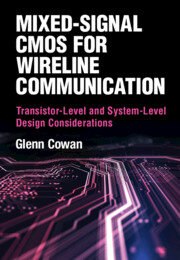 Mixed-Signal CMOS for Wireline Communication
Mixed-Signal CMOS for Wireline Communication Book contents
- Frontmatter
- Contents
- Preface
- Notation and Acronyms
- 1 Introduction to Wireline Communication
- 2 Electrical Channels
- 3 Decision Circuits
- 4 Equalization
- 5 Electrical-Link Transmitter Circuits
- 6 Electrical-Link Receiver Front-Ends
- 7 Optical Channels and Components
- 8 Optical-Link Transmitter Circuits
- 9 Optical Receivers
- 10 Low-Bandwidth (Equalizer-Based) Optical Receivers
- 11 Advanced Topics in Electrical and Optical Links
- 12 Overview of Synchronization Approaches
- 13 Oscillators
- 14 Phase-Locked Loops and Injection-Locked Oscillators
- 15 Clock and Data Recovery
- Appendix A Frequency Domain Analysis
- Appendix B Noise Analysis
- References
- Index
7 - Optical Channels and Components
Published online by Cambridge University Press: 05 December 2024
- Frontmatter
- Contents
- Preface
- Notation and Acronyms
- 1 Introduction to Wireline Communication
- 2 Electrical Channels
- 3 Decision Circuits
- 4 Equalization
- 5 Electrical-Link Transmitter Circuits
- 6 Electrical-Link Receiver Front-Ends
- 7 Optical Channels and Components
- 8 Optical-Link Transmitter Circuits
- 9 Optical Receivers
- 10 Low-Bandwidth (Equalizer-Based) Optical Receivers
- 11 Advanced Topics in Electrical and Optical Links
- 12 Overview of Synchronization Approaches
- 13 Oscillators
- 14 Phase-Locked Loops and Injection-Locked Oscillators
- 15 Clock and Data Recovery
- Appendix A Frequency Domain Analysis
- Appendix B Noise Analysis
- References
- Index
Summary
Every designer of integrated circuits for optical transceivers needs to be familiar with the fundamentals of optical channels and the devices that convert electrical signals to optical signals and vice versa. This chapter provides a concise overview starting with optical fibre. Single-mode and multi-mode fibre are described as well as the characteristics of on-chip optical channels. Optical-to-electrical conversion through photodiodes is discussed along with simple electrical models. Considerations for implementing photodiodes entirely in silicon are included in a separate section. On the transmitter side, both direct modulation and indirect modulation are presented. This chapter summarizes the physics of laser diodes and gives a simplified model of the electrical dynamics and their electrical to optical conversion. Similarly, an electrical model and a model for E/O conversion will be presented for Mach–Zehnder interferometer-based modulators. The chapter closes with an overview of silicon photonics.
Keywords
- Type
- Chapter
- Information
- Mixed-Signal CMOS for Wireline CommunicationTransistor-Level and System-Level Design Considerations, pp. 179 - 202Publisher: Cambridge University PressPrint publication year: 2024
